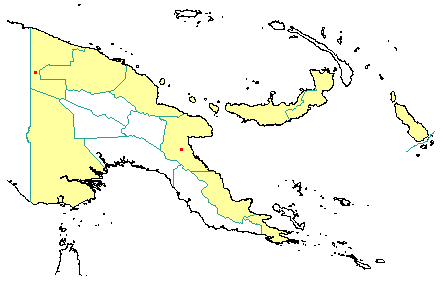
in PNGplants database
PNGTreesKey – Celtis hildebrandii Soepadmo |
Barry Conn (NSW) & Kipiro Damas (LAE).
Guide to trees of Papua New Guinea
Copyright held by the authors, National Herbarium of New South Wales, and Papua New Guinea National Herbarium
Flora Malesiana, Series 1 Vol. 8: 63-65 (1977) Fig. 20-23.
Family: Cannabaceae
Dicotyledon
Timber Group: Non-timber species
Field Characters: Large canopy tree (up to 40 m high, rarely to 45 m); Bole cylindrical (up to c. 100 cm diam.); straight; buttresses buttresses present (buttresses up to 2.8 m high); spines spines absent; aerial roots aerial roots absent; stilt roots stilt roots absent; Bark grey or pale brown, slightly rough or smooth, finely fissured or often pustular, lenticels rounded/swelling; Subrhytidome (under-bark) green; less than 25 mm thick, 10.0-14.0; bark blaze consisting of one layer; faintly to non-aromatic; outer blaze white or yellow (pale (cream-coloured), speckled (red-brown); inner blaze white or yellow (pale (cream-coloured), speckled (red-brown); bark exudate (sap) present, colourless, flowing or not readily flowing (spotty), colour changing on exposure to air, to black or purple (after some time), not sticky or slightly sticky; terminal buds not enclosed by leaves.
Indumentum: Complex hairs absent; stinging hairs absent; mature twig indumentum (hairs) present, hairs dense to sparse.
Leaves: Leaves spaced along branches, spiral (leaves occurring singly at a node and arranged spirally up the branchlet), simple (a leaf composed of a single blade); petiole present, not winged, attached to base of leaf blade, not swollen; leaves broadest below middle, (5.0-) 8.0-11.0 (-14.0) cm, (3.0-) 4.0-6.0 (-8.0) cm; mostly very asymmetric, entire, not dissected or lobed, acute to acuminate, venation distally pinnate or at base trinerved, secondary veins open, prominent, intramarginal veins absent; leaves lower surface green, upper surface dark green (glossy), indumentum (hairs) absent; absent; domatia absent; stipules present, free (peltately attached, overlapping), laterally placed, not encircling the twig, leafy, not fringed, large, persistent.
Flowers: Inflorescence terminal (sub (on new shoots) or axillary, flowers on a branched axis, cones absent; flowers unisexual, unisexual with male and female flowers on the same plant, stalked, flowers with many planes of symmetry, 2.0-3.0 mm long, diameter small (up to10 mm diam.); perianth present, with all sepals and/or petals (hence tepals) similar, inner perianth pale yellow; 5, free; stamens 5, present, free of each other, free of the perianth; ovary superior, carpels joined (when more than one), locules 1; styles absent.
Fruits: Infrutescence arranged on branched axis, fruit 10.0-12.0 mm long, not spiny, fleshy, simple, indehiscent, drupe; seeds 1, about 10 mm long, not winged, broad (as wide as long), seed 1-10 mm diam.
Distribution: West Sepik, East Sepik, Madang, Morobe, Western, Northern, Milne Bay, New Britain & Bougainville.
 | Botanical records in PNGplants database |
Notes: Notes The genus Celtis was previously classified in the separate family Ulmaceae.